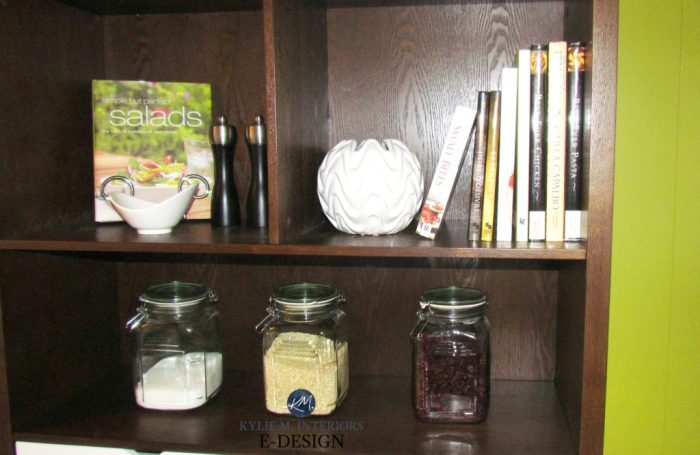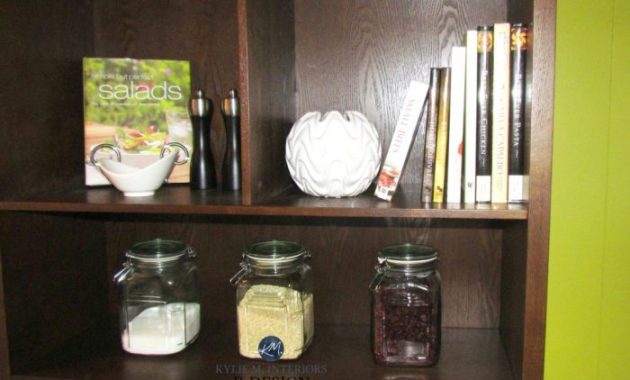Decorative Elements for Open Shelves

Kitchen open shelf decor – Open shelving offers a fantastic opportunity to showcase your personality and style in the kitchen. Unlike closed cabinets, open shelves demand careful curation; every item becomes part of the overall aesthetic. Choosing the right decorative elements is key to creating a space that’s both visually appealing and functional.
Let’s move beyond the usual suspects and explore some unique decorative options that will elevate your kitchen’s open shelving to the next level. The right combination of objects can transform your shelves from simple storage into a stunning design feature.
Unique Decorative Elements for Open Shelves
Here are five unique decorative elements that go beyond the typical cookbook or spice rack, offering opportunities for creativity and visual interest:
- Artisan Pottery: A collection of uniquely shaped and glazed bowls, vases, or pitchers in varying sizes and colors adds a touch of handcrafted charm. The uneven textures and subtle variations in color create a dynamic display.
- Vintage Wooden Utensils: Seek out antique rolling pins, wooden spoons, or even old-fashioned butter churns. Their weathered appearance and rustic charm contribute a sense of history and warmth to the kitchen.
- Textured Baskets: Woven baskets, particularly those with intricate patterns or interesting textures like seagrass or bamboo, offer both storage and visual appeal. They can hold fruits, vegetables, or even tea towels, adding a touch of natural elegance.
- Glass Canisters with Dried Ingredients: Instead of storing dried goods in plain containers, opt for beautiful glass canisters with airtight lids. Fill them with colorful lentils, beans, or grains for a visually striking and organized display.
- Ornamental Metal Trays: A decorative metal tray, perhaps with an etched design or a unique patina, can serve as a base for smaller items, grouping them together and adding a touch of metallic shine and visual weight to the shelf.
Incorporating Texture Through Decorative Objects and Shelf Materials
Texture plays a crucial role in creating visual depth and interest on open shelves. The interplay of different textures prevents the display from feeling flat or monotonous. Consider the materials of both your decorative objects and the shelves themselves.
For example, the smooth surface of glass canisters contrasts beautifully with the rough texture of a woven basket. Similarly, the cool, smooth surface of a marble shelf provides a striking backdrop for the warm, rustic texture of vintage wooden utensils. Using a variety of materials—wood, metal, glass, ceramic, woven fibers—creates a visually rich and engaging display. Even the shelf material itself contributes; consider the contrast between a sleek, polished wood shelf and the items displayed on it.
So, you’ve got those gorgeous open shelves in your kitchen, begging for some personality, right? But beyond the usual mason jars and cookbooks, you need oomph. That’s where a dash of humor comes in – maybe a quirky sign or two? Check out these ideas for funny kitchen wall decor to get inspired! Then, strategically place your funny finds amongst your open shelf displays for a kitchen that’s both stylish and laugh-out-loud hilarious.
Visual Representation of Decorated Open Shelves
Imagine a three-tiered open shelf unit made of light-colored wood. On the top shelf, a collection of three artisan pottery bowls in varying shades of terracotta and cream are artfully arranged. Next to them sits a vintage wooden rolling pin, leaning casually against the back. The middle shelf features a large woven seagrass basket filled with brightly colored lemons and limes, flanked by two glass canisters filled with green lentils and brown rice.
On the bottom shelf, a rectangular metal tray with an ornate design holds a small collection of antique-looking spoons and a small, decorative ceramic jar.
Open Shelf Materials and Finishes

Choosing the right materials and finishes for your open kitchen shelves is crucial, impacting not only the aesthetic appeal but also the longevity and practicality of your shelving system. The material you select will dictate the overall style of your kitchen, while the finish adds personality and protection. Let’s explore some popular options and their characteristics.
Material Comparisons: Wood, Metal, and Glass, Kitchen open shelf decor
Selecting the perfect material for your open shelves involves considering several factors, including durability, style, and maintenance. Each material offers a unique set of advantages and disadvantages.
- Wood: Wood shelves bring warmth and a natural, inviting feel to any kitchen. They’re versatile and can be stained or painted to match any décor.
- Pros: Durable (with proper care), aesthetically pleasing, easily customizable, can be relatively inexpensive.
- Cons: Susceptible to water damage, scratches, and staining; requires regular maintenance (e.g., oiling, sealing).
- Metal: Metal shelves offer a modern, industrial, or minimalist aesthetic. They’re typically very durable and easy to clean.
- Pros: Strong, durable, easy to clean, resistant to water damage, available in various styles.
- Cons: Can be expensive, may show fingerprints or smudges, can feel cold to the touch, might require protective coatings to prevent rust.
- Glass: Glass shelves create a sleek, contemporary look and offer a sense of spaciousness, especially in smaller kitchens.
- Pros: Visually appealing, easy to clean, creates a feeling of openness, allows light to pass through.
- Cons: Can be fragile and prone to breakage, requires careful handling, can show fingerprints and smudges easily, may not be suitable for heavier items.
Finish Options for Open Shelves
The finish you choose significantly impacts the overall look and feel of your shelves, as well as their resistance to wear and tear. Consider both the aesthetic and practical aspects when making your selection.
| Material | Finish | Pros | Cons |
|---|---|---|---|
| Wood | Natural | Shows wood grain, warm and inviting | Requires regular oiling/sealing |
| Wood | Stained | Enhances wood grain, customizable color | Can be difficult to repair if damaged |
| Wood | Painted | Durable, easily customizable color | Can chip or scratch over time |
| Wood | Lacquered | Protects from water and scratches, high gloss | Can yellow over time |
| Wood | Waxed | Enhances natural beauty, water-resistant | Requires regular reapplication |
| Metal | Powder Coated | Durable, scratch-resistant, variety of colors | Can chip if impacted |
| Metal | Polished | Sleek, modern look, reflects light | Shows fingerprints easily |
| Metal | Brushed | Subdued sheen, hides fingerprints | More prone to scratching |
| Metal | Chrome | Classic, shiny, easy to clean | Can show water spots |
| Metal | Blackened Steel | Industrial chic, low maintenance | Can show scratches more easily |
| Glass | Clear | Maximizes light, shows off displayed items | Shows fingerprints and smudges easily |
| Glass | Frosted | Diffuses light, offers privacy | Can be more difficult to clean |
| Glass | Tinted | Adds color, reduces glare | Can be more expensive |
| Glass | Etched | Adds texture and design, hides imperfections | Can be more difficult to clean |
| Glass | Mirrored | Creates a sense of space, reflects light | Shows fingerprints and smudges easily |
Quick FAQs: Kitchen Open Shelf Decor
How do I prevent dust buildup on open shelves?
Regular dusting with a microfiber cloth is key. Consider using glass doors or strategically placed decorative items to minimize dust exposure on frequently used items.
What are some budget-friendly ways to decorate open shelves?
Repurpose existing items like jars, baskets, and vintage containers. Use natural elements like branches or plants to add visual interest. Consider DIY projects like painted ceramic pieces or upcycled trays.
How do I choose the right lighting for open shelves?
Under-cabinet lighting highlights items and prevents shadows. Recessed lighting provides overall illumination, while accent lighting can focus on specific decorative pieces.
Are open shelves suitable for small kitchens?
Yes, but careful planning is crucial. Opt for shallower shelves and prioritize functionality and organization to prevent a cluttered appearance. Consider using vertical space effectively.

